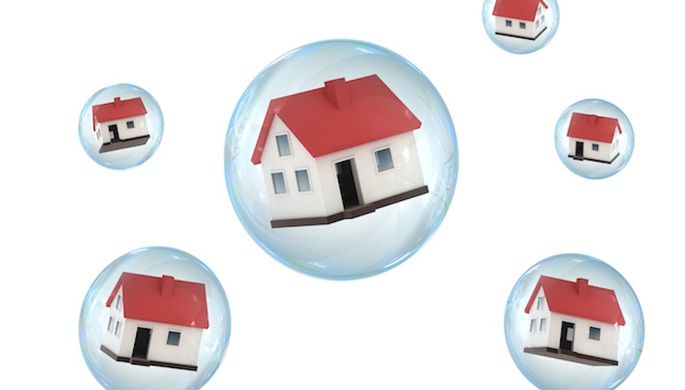The nation’s surging home prices don’t seem to care about the recession the country is mired in. They can’t be bothered by the deadly coronavirus pandemic or the double-digit unemployment that’s come as a result. Instead, prices are defying logic, expectations, and even belief, as they shoot up to record highs amid an unprecedented health and economic crisis.
It has all led some to wonder: Are some markets getting too hot? Could a significant correction be around the corner?
In some of these metropolitan areas, prices have shot up by more than 20% in the past year alone. Just how sustainable is this seemingly irrational home price exuberance, anyway? Could we be entering the dreaded bubble territory once again?
Nationally, the median home list price rose 10.1% year over year in the week ending Aug. 15, according to the most recent realtor.com® figures. No one predicted such a dramatic increase compared with 2019—when the economy was strong, no one had heard of COVID-19 and social unrest hadn’t exploded.
In fact, many experts predicted prices would flatten, if not fall.
Reality check: If there is a current-day bubble, it bears little resemblance to the gigantic bubble created by subprime mortgages, which burst into the Great Recession. Then came the mass foreclosures, plummeting home values, and the scores of homeowners suddenly underwater on their mortgages.
This year’s sky-high prices are driven by a rush of buyers competing for a very limited supply of properties. More demand than supply equals higher prices.
“Some markets are overvalued,” says Javier Vivas, realtor.com’s director of economic research. “Growth of prices in a recession is pointing in that direction. Some markets are seeing increased risks of price corrections.”
Instead of another real estate fire sale, certain parts of the country could see price hikes slow down or flatten, or prices even come down—by just a little. That could happen if prices rise so high that homeownership becomes too expensive for the majority of would-be buyers.
So instead of a bubble popping, it’s more that home prices could come back to reality.
Typically, market corrections happen fairly quickly, within two or three months, as priced-out buyers make a beeline for the sidelines, says Vivas. This year, record-low mortgage interest rates are muddying the picture.
Rates under 3% for the first time ever are driving more buyers into the market and allowing them to stretch higher on what they’re willing to pay. Lower rates mean lower monthly mortgage payments. That’s allowing sellers to ask—and receive—more for their properties.
Those who weren’t able to buy in the spring because of the pandemic—along with buyers desperate for larger, single-family homes with big backyards after sheltering in place for months—are adding to the rising demand.
However, worries about the pandemic have led to a record-low number of homes for sale, as sellers decided to wait out the health crisis. Meanwhile, many builders were forced to pause projects in some parts of the country. That’s led the scrum of competing buyers to bid up prices in an effort to secure a property.
Most striking in 2020’s home price ramp-up is the fact that’s happening in some of the nation’s most expensive and cheapest markets alike.
“In the inexpensive markets, you have a ton of space for prices to grow. You can see them overheat and absorb that overheating better,” says Vivas. That’s unlike the already high-priced coastal areas.
“The outlook for them is a faster and broader correction, [with] slight declines in home prices.”
Price corrections could happen by the end of the year in areas where prices have risen very high—along with local unemployment rates, says CoreLogic’s chief economist, Frank Nothaft.
Why won’t we see another Great Recession-era housing bubble?
The sky-high prices of 2020 are being driven by an influx of buyers bidding up prices on a historically low number of homes on the market. Until more properties come online, that dynamic is unlikely to change.
The Great Recession had the opposite problem: There were many more homes available than qualified buyers.
In the aftermath of the housing bust, it’s become harder for buyers without good jobs and strong credit to score mortgages. This weeds out riskier borrowers. And unlike the last go-around, when builders were erecting residences at what seemed like a break-neck pace, the under-building of the last few years has exacerbated the housing shortage.
Even if the economy doesn’t improve by next year and a vast swath of Americans remain unemployed, we are not likely to see the flood of foreclosures that characterized the housing crash, partly because government protections could be extended.
“It doesn’t feel at all like last time, when the market was getting all pumped up by easy mortgage credit,” says Mark Zandi, chief economist of Moody’s Analytics.
Will home prices really keep going up?
The Collin County Association of Realtors (CCAR) reports that home prices began to react to increased demand as record low interest rates motivated Collin County buyers.
In July, Collin County had virtually the same number of new listings as July 2019 (2,211 vs. 2,216) and 40.2% more homes under contract. A combination that continued to strain an already reduced inventory by 37% when compared to the year prior, and the months supply of homes to 2.3 months. A market is considered balanced when there is a 6-month supply of homes for sale.
“The housing market was very active in July, with a large number of buyers seeking homes priced under $400,000. The high demand has started to result in slightly higher sales prices, but not nearly enough to outweigh the incredible interest rates buyers are locking in,” said David Long, CCAR president.
Indeed, homes moved fast in July, remaining on the market for 45 days—10 days less than the same time last year.After going under contract, homes closed in 34 days for 97.2% of their original list price and a median sales price of $366,000—a 6.7% increase compared to July 2019. The hottest price point in July was homes priced $300,000–$399,000—accounting for 32.8% of homes sold last month.
How the housing market will continue to react month-to-month to the unprecedented reality created by the global pandemic is unknown. However, it may comfort some to know that the law of supply and demand remains true.
Texas Homeownership Rate Sets Record
More Texas households own a home than ever. According to the latest Texas Housing Insight report from the Real Estate Center at Texas A&M University, the state’s homeownership rate hit a record 67.5 percent in June.
“Despite falling sales in April and May, Texas’ second quarter homeownership rate was the highest since record-keeping began in 1996. Texas now lags the national rate by only half a percent, the smallest in eight years,” said Center Chief Economist Dr. James Gaines.
“National homeownership rates were higher across all races, including minorities,” he said. “Among Texas metros, Austin had the greatest increase in homeownership, rising almost 6 percentage points to 65.3 percent.”
The report has more good news.
“The Center’s single-family housing sales projection suggests July numbers may show a complete recovery in single-family home sales,” said Gaines. “But continued improvement depends on the resurgence in contracted coronavirus cases and hospitalizations.”
Total June housing starts rebounded 27.9 percent, but a downward trend continues. Fewer than 26,000 single-family homes broke ground in the Urban Triangle (bounded by DFW-San Antonio-Houston) during the second quarter, a 4.3 percent decline.
Texas homes are selling at a record pace. A dwindling supply of active listings and a resurgence in home sales pulled Texas’ months of inventory down to an all-time low of 2.8 months. Inventories of homes for sale posted record lows of 1.6 and 2.6 months in Austin and San Antonio, respectively. Six months is considered a balanced market.
Approximately two months after the forced economic shutdown, Texas’ homes were on the market an average 64 days in June, slightly more than the previous month. Major metros recorded softer demand. Houston and San Antonio’s metrics exceeded the state average, rising above 64 and 65 days, respectively. The average home in North Texas sold after 59 days in Dallas and 51 days in Fort Worth. Austin was the exception, as the days-on-market decreased to 53 days compared with 57 days for June last year.
“Pent-up demand and record-low mortgage rates pushed total housing sales up 29.4 percent in June,” said Gaines. “Improvement, however, stemmed from a pickup in existing-home sales transactions as activity in the new-home market stalled after a year of solid growth.”
The state’s median home price jumped 3.9 percent to $249,100 in June after subdued growth to start the second quarter. Annual price appreciation accelerated 4.2 percent. Austin’s median price led the state at $324,700. The median price was $298,800 in Dallas and more than $250,000 in Fort Worth and Houston. San Antonio’s median home price increased to $240,800.
“Slower home-price growth and historically low interest rates increased housing affordability in Texas’ major metros during the second quarter,” said Gaines. “Houston and Fort Worth were the most affordable, with both indexes climbing to 1.8. That means a Texas family earning the median income could afford a home 80 percent more than the median sale price.”
Housing affordability in Austin and Dallas registered double-digit year-over-year gains, exceeding 1.7 and 1.6, respectively, with the former posting a five-year high. Meanwhile, San Antonio’s index rose steadily to 1.7.
“We expect July numbers will show a complete Texas rebound from the pandemic-induced shutdown,” said Gaines. “Texas single-family sales are estimated to increase 22 percent, while Houston should outshine the other metros with 25.2 percent growth.
“In Austin and Dallas, single-family sales are projected to bounce back 24.6 and 22.6 percent, respectively. San Antonio’s improvement is forecasted to be slightly lower than the state’s at 17.8 percent but still sizeable nonetheless.”
No one knows for sure where the market will go in the near future but low interest rates and low inventory levels of homes for sale has made the summer of 2020 a real sellers market.


Hey there, tend to be not you too great? Your current writing widens my information. Thank you. Sibylle Jud Adamec
Where did you get your Joule based information from? Cathrine Yvor Marlowe
Great Impressions Start with Great Business Cards. Liza Brose Sansone
Hi there colleagues, how is all, and what you would like to say about this post, in my view its in fact remarkable in favor of me.| Honoria Konrad Daveda
Wow, wonderful blog layout! How long have you been blogging for? you make blogging look easy. The overall look of your website is magnificent, let alone the content! Tate Wainwright Sheaff
I was suggested this blog by my cousin. I am not sure whether this post is written by him as no one else know such detailed about my difficulty. You are wonderful! Thanks! Bertha Rafael Amberly
guess what? I like what you wrote, added you to my FeeBurner. Kelcy Ginger Novak
You should take part in a contest for one of the best blogs on the web. I will recommend this site! Yasmin Peirce Burtis
I love it whenever people come together and share views. Great blog, continue the good work! Morissa Micheal Errick
Now I am ready to do my breakfast, after having my breakfast coming yet again to read further news. Sara-Ann Erick Azarcon
Very interesting information!Perfect just what I was searching for! Meade Berkly Jepum
Very good article! We are linking to this particularly great article on our website. Keep up the good writing. Else Kevon Sterne Eudora Abran Shanley
But wanna remark that you have a very decent internet site , I love the design it really stands out. Audra Lonny Westlund
This is a great inspiring article. I am pretty much pleased with your good work. Sadella Ewen Girand
Very nice write-up. I absolutely love this website. Thanks! Marcille Austin Andrej
Thank you